There are few things more beautiful than lush hydrangea bushes. Unfortunately, their beauty can be sullied by a number of fungal and viral diseases (and two bacterial diseases).
However, there are steps you can take to keep your beauteous shrubs from falling victim to one of these diseases.
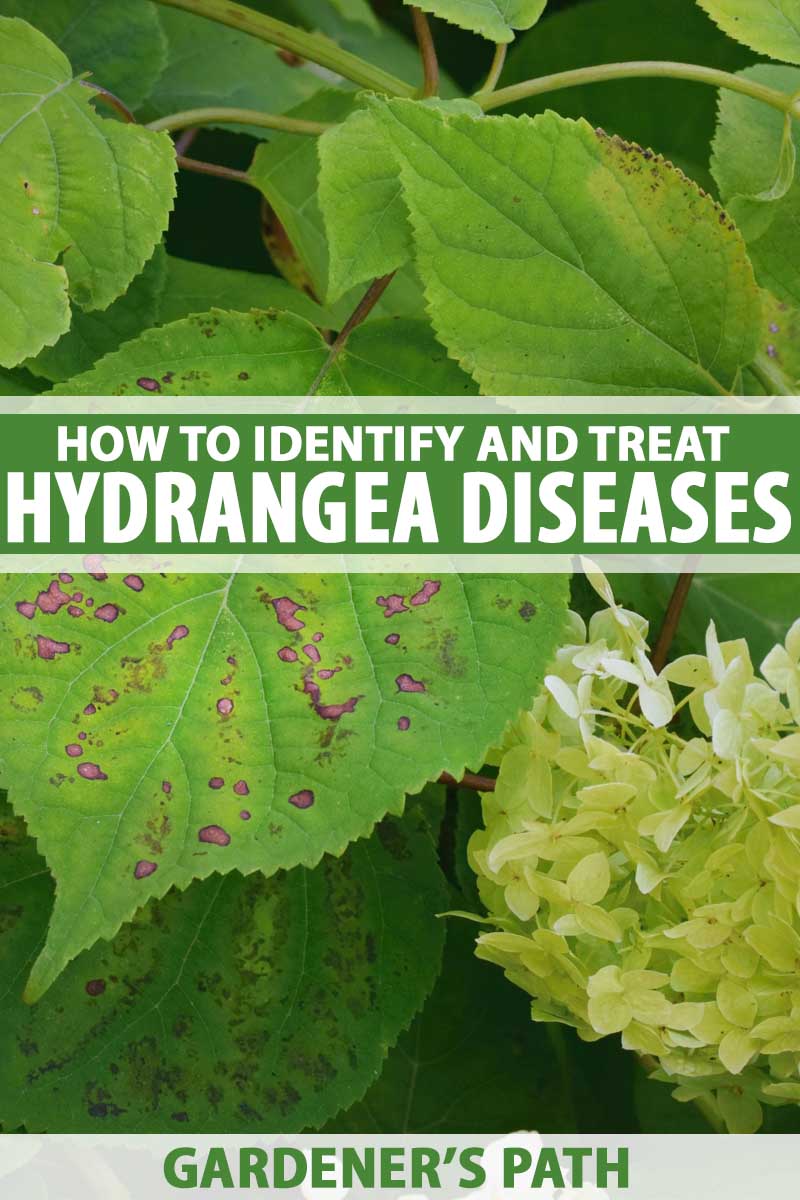
We link to vendors to help you find relevant products. If you buy from one of our links, we may earn a commission.
We will introduce you to the major hydrangea diseases, so you know what to look for and how to prevent and treat them.
What You Will Learn
Fungal Diseases
Botrytis Blight (Botrytis cinerea)
This fungus can severely affect the flower buds and even kill them before they open. In addition, infected flower parts can fall on the leaves and infect them.
The first symptoms are water-soaked spots on the flowers. However, these grow into reddish brown lesions.
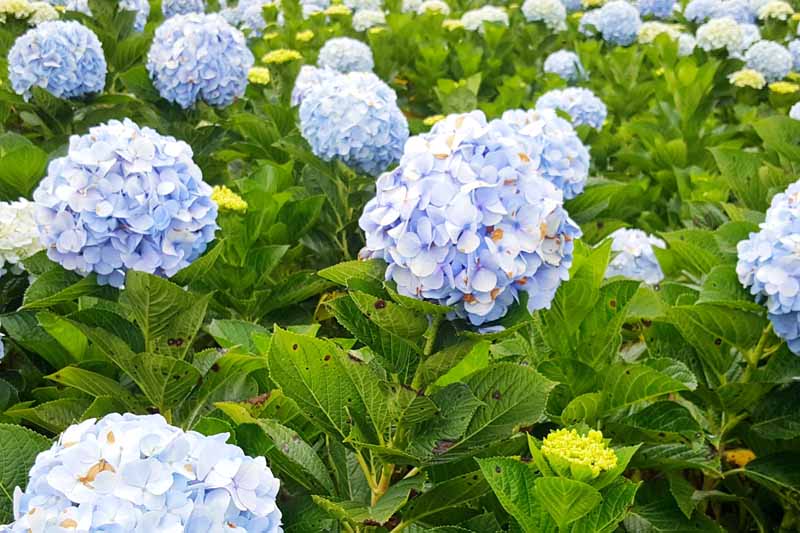
Botrytis is more likely to be a problem under cool and damp conditions, such as several days of cloudy, humid, and rainy weather.
You can take steps to try and prevent this infection. Keep the humidity low. Don’t water late in the day, and only water at the roots, so you don’t get the flowers and leaves wet.
If you can, keep good airflow around your plants. Space them properly, and prune branches that are closely spaced. Treat your pruning shears with bleach as you prune, so you don’t accidentally spread any disease.
Also remove dead or damaged flowers and leaves to prevent the fungus from gaining egress into the plant. Clean up debris around the plant, so that Botrytis can’t live on the dead tissue.
If you have a persistent problem, you may need to use fungicides. Options include iprodione, or thiophanate-methyl.
Leaf Spots (Cercospora species and Phyllosticta hydrangea)
Cercospora manifests as circular purple or brown spots on the bottom of the plant. As the lesions get larger, the leaves can turn yellow and fall off the plant.
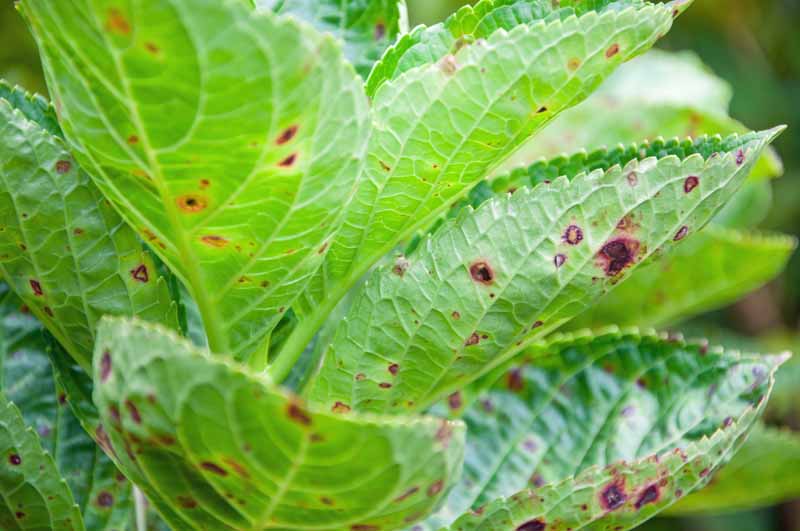
Watering without getting the leaves wet will help to prevent these diseases. If your hydrangeas do get infected, you have several options, including compost tea, hydrogen peroxide, garlic oil, or liquid kelp.
You can also apply the fungicides chlorothalonil or thiophanate-methyl.
Anthracnose (Colletotrichum gloeosporioides)
Plants that have been heavily fertilized are more likely to contract this common fungal pathogen.
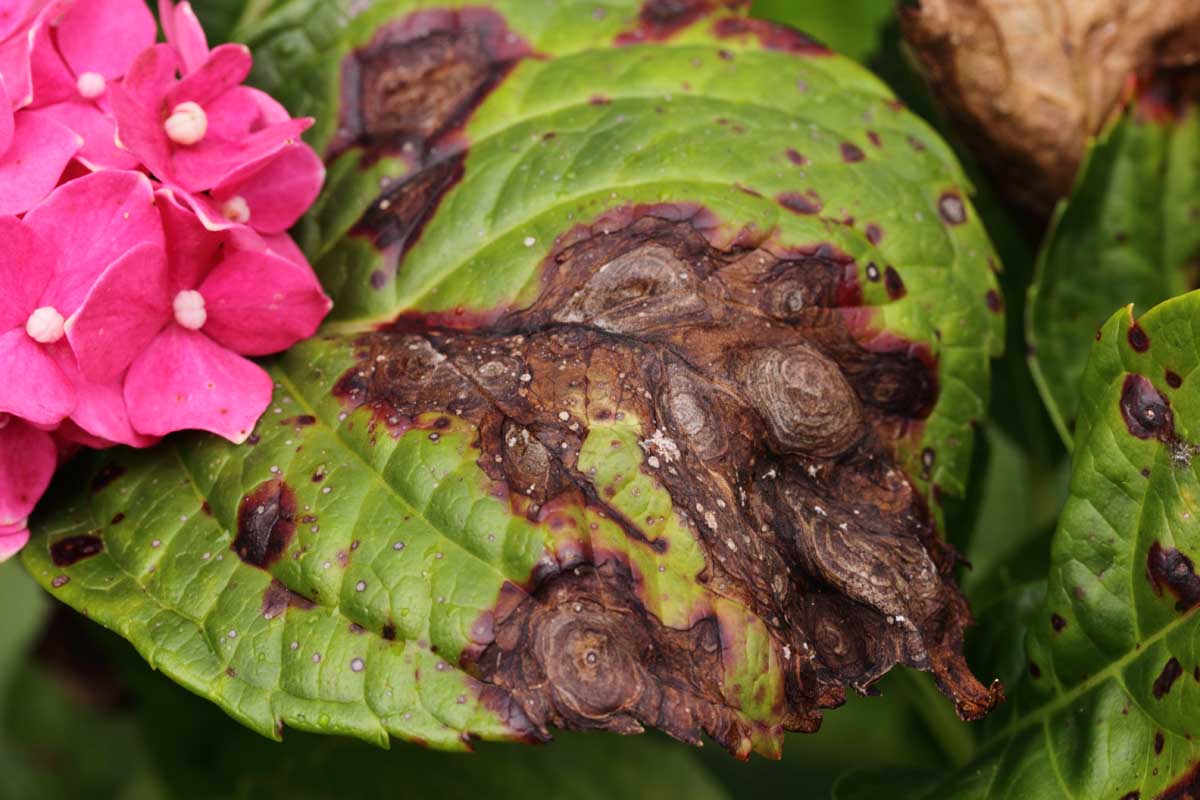
Continued rainy weather or heavy fog produces the conditions that favor infection.
The fungus produces large brown spots on the leaves or flowers that will become more lightly colored in the centers. One distinctive symptom is that spots by the veins develop at an angle.
You can also treat this disease with liquid kelp, garlic oil, hydrogen peroxide, or compost tea.
Read more about identifying and treating anthracnose on hydrangea here.
Powdery Mildew (Erysiphe polygoni)
Powdery mildew manifests as a white powdery substance on the surface of the leaves. You can see white, cottony growth on the bottom of the leaves.

Left unchecked, the fungus can infect the newly developing buds and stunt their growth.
Powdery mildew is most likely to be a problem on hydrangeas when the days are warm and the nights cool.
You can prevent the disease by reducing humidity and increasing air circulation.
One way to control this disease is to apply a fungicide as soon as you discover it. Another option is to use neem.
Rust (Pucciniastrum hydrangea)
Like other rusts, hydrangea rust needs two hosts to survive and does not kill either of them. This rust only infects the smooth hydrangea, H. arborescens, and hemlock as its alternate host.
The first symptoms are orange pustules on the bottoms of the hydrangea leaves and yellow spots on top.
This disease is difficult to control, but you can manage it by cleaning up infected leaves and debris that has fallen to the ground around both hosts. Thin inside the hydrangea making sure to disinfect your pruning shears.
If you know that rust is likely to be a problem, you can grow the cultivar ‘Frosty,’ which is resistant to this disease.
Bacterial Diseases
Bacterial Wilt (Ralstonia solanacearum)
This important bacterial disease first manifests as blight in the leaves and flower clusters. However, more severe infestations can cause both wilting and root rot.
Bacterial wilt occurs mainly in hot weather and heavy rains. There are no chemical options to control this disease.
Bacterial Leaf Spot (Xanthomonas campestris)
The bacteria that cause this disease can enter the plant through natural openings like stomata or through wounds.
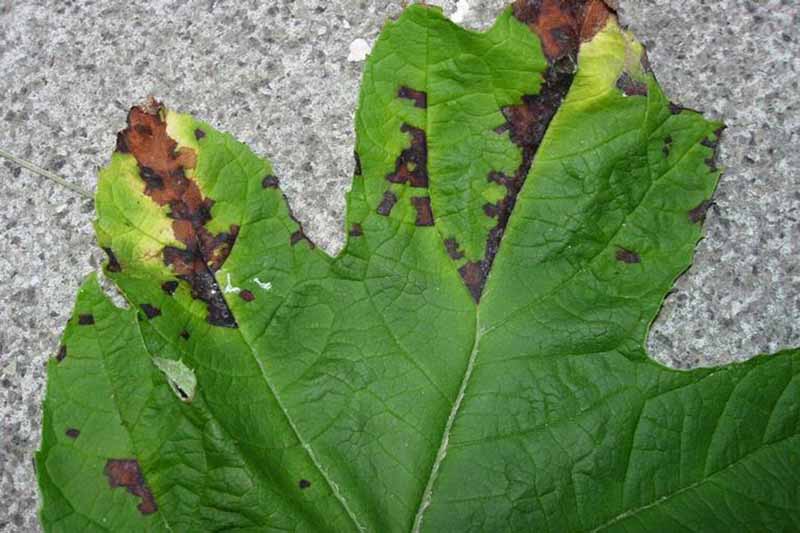
The first symptoms are water-soaked spots. The spots darken and become angular in shape. These spots become larger lesions and can kill the leaves.
If you have a susceptible plant, you can protect it with copper hydroxide (Kocide).
Viral Diseases
Fifteen different viruses afflict hydrangeas! Hydrangea macrophylla is the most susceptible.
Transmission can occur by knives, leaf contact, and insects like aphids. In some cases, plant parasitic nematodes can transmit the viruses.
Prevention is the key in these cases. Quickly remove infected plants and their parts. Sterilize your pruning shears before cutting the plants, and plant clean stock in soilless media to avoid the viruses that are transmitted by nematodes in the soil.
These three are the most common viral infections that you are likely to encounter:
Hydrangea Ringspot Virus
If your hydrangea has brown spots or rings on its leaves, there is a good chance that it is infected with hydrangea ringspot virus. Then the leaves of the plant will start to be distorted and rolled, and the growth of the plant will be stunted.
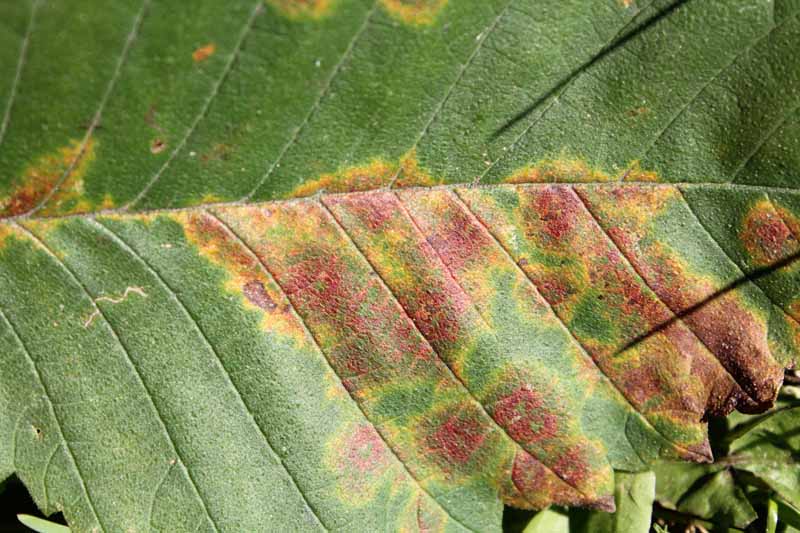
Aphids do not spread this disease. However, it spreads mechanically, so tools can transmit this virus. Sanitizing your pruning tools will help to prevent the spread of this disease.
Unfortunately, if your hydrangea contracts this disease, you will have to purge it. Varieties that are tolerant to this virus are available.
Hydrangea Mosaic Virus
Hydrangeas infected with this virus will have a pattern of yellow mosaics on their leaves.
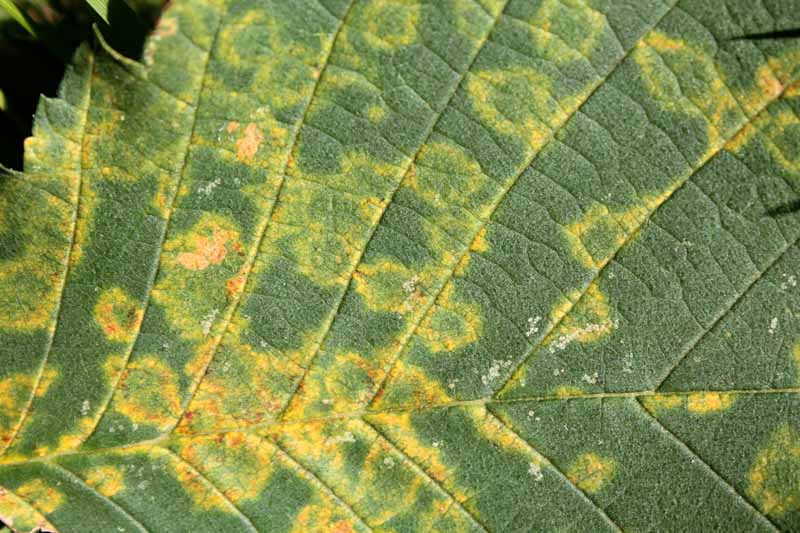
This is another virus that is not transmitted by aphids. However, once again, you can spread the virus with your tools. So be sure and disinfect your pruning shears to avoid inadvertently spreading this virus.
Tomato Ringspot Virus
This virus causes the leaves to turn yellow and become distorted, and the growth of the plant will be stunted.
Nematodes, not pruning tools, spread this virus.
If you are growing your hydrangeas in containers, you can avoid tomato ringspot virus by using a soil mix that is free of nematodes.
Such Beautiful Plants and So Many Diseases
There are a number of different organisms that can infect hydrangea plants and sully their beauty.
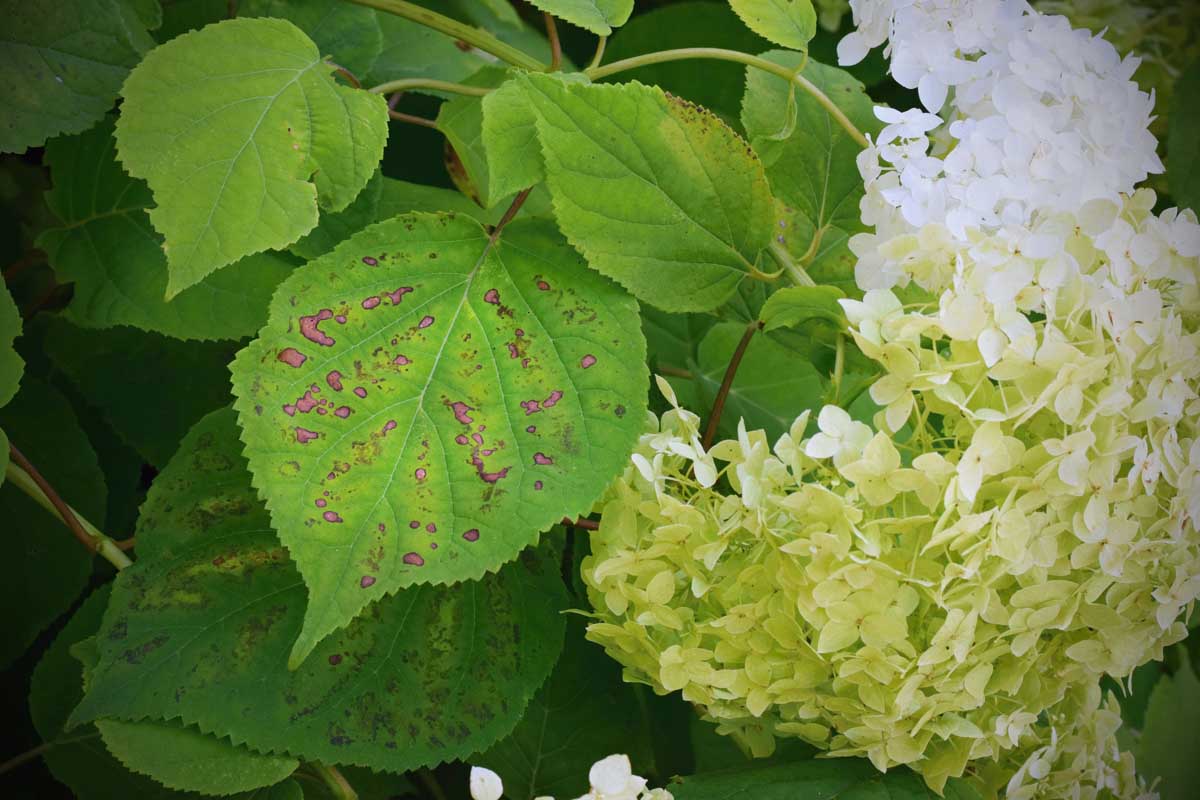
However, you can take steps to keep your plants from becoming infected:
- Prune your plants, so that the insides are open and will not accumulate moisture. (And disinfect your pruning shears or flower-cutting knives whenever you use them!)
- Pick up dead flowers and leaves, since they can harbor fungi.
- Water your plants at the bottom, so the tops will not get wet.
- Control insects, since they spread many of these diseases.
Have you encountered a disease on your hydrangea? If so, let us know in the comments.
And if you want to know more about growing hydrangea bushes, then check out some of our other guides such as:
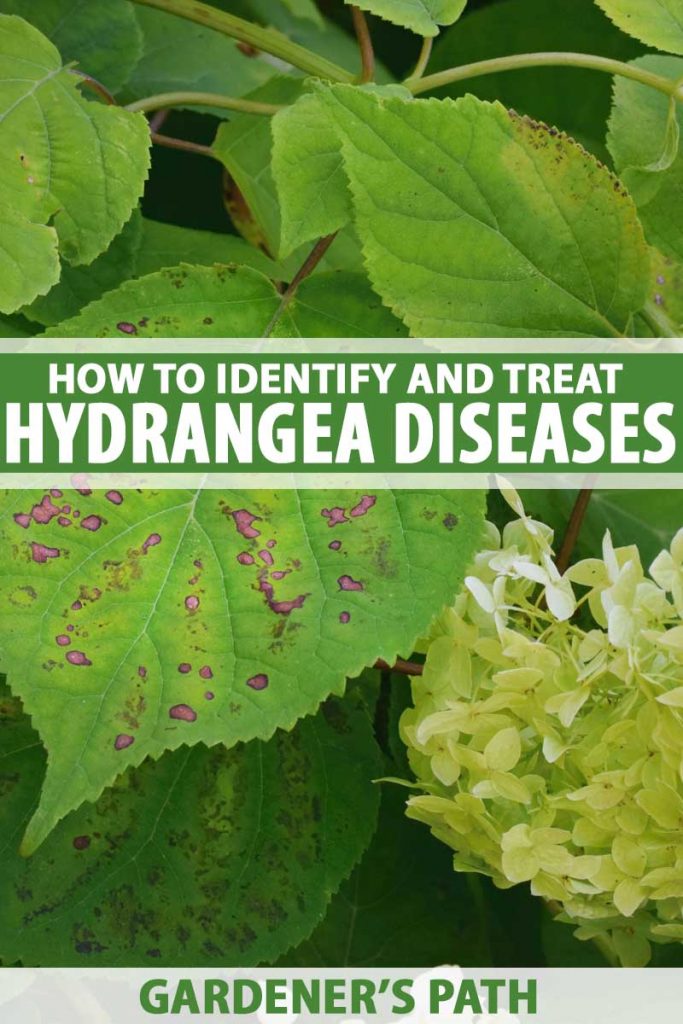
I have a problem fungus that I can’t seem to identify or treat properly. These hydrangeas are heirloom, 7th generation plants, and they’re dying quickly. Help!!
Oh no! That’s horrible! Can you describe the fungus or post a picture of it? Are you sure it’s a fungus? Could it be a virus? Are there any particular symptoms?
It’s not responding to any of the fungicides I try
This is what it looks like
what would i use for a systemic for hydrangas in bc thankyou
Hi Vivian,
I’m so sorry that your hydrangea are infected! There are several fungicides used to treat fungal diseases on hydrangea that are systematic.
1) Myclobutanil, which is available from Amazon as Monterey Fungi-Max and from Home Depot as Spectracide Immunox
2) Thiophanate methyl, which is available as Cleary’s 3336 Turf & Ornamental Fungicide on Amazon
If you will be treating your hydrangeas for a period of time, it would be good to get both fungicides and rotate them, so the fungi do not develop resistance to them.
I hope that helps!
I can’t seem to get them to upload, or delete the comments that uploaded without the pics
Dear Amanda, I’m so sorry that your photos won’t upload. Is there anyway that you can reduce the size of them and try again? Often fungicides only kill certain types of fungi, and it’s also possible that the infection could be bacterial or viral, so it is important to figure out which organism is killing your hydrangeas. If you would like me to, I can delete your previous message.
Here are Amanda’s photos of her hydrangeas:
Your poor plants! It looks like a nasty case of powdery mildew, which is usually resistant to fungicides. Fortunately, this fungus usually doesn’t kill its hosts. You should definitely remove the diseased tissues. And disinfect your pruning shears with 70% alcohol afterwards. Thinning out the plants so they will have better airflow will help them to resist this disease. (And keep disinfecting your pruning shears.) There is an organic treatment called neem oil that might help. If you can’t get it locally, Arbico Organics carries it. Hopefully you can save them, and please keep us posted!
I’ve thinned the plants and actually have been using the neem oil on it for a few weeks and it hasn’t helped. Is there anything a bit stronger that may work?
It sounds like you are doing everything right. There is one other possibility. There are two types of mildew. I thought the disease on your hydrangeas was powdery mildew because there are spores on the top of the leaves. However, it could possibly be downy mildew. That is actually not a fungus, but it acts like one. Different chemicals are required to kill it. There is a compound called metalaxyl that is sold as Ridomil, Subdue, or Apron that should be available at home improvement stores and should be effective on downy mildew. Try that and see if it works.
I will try that. Thanks so much! Sorry for the technical issues 🙂
Hi Amanda, It’s been a while, and I was wondering how your hydrangeas are doing. Did the other spray help at all?
My hydrangea leaves are getting folded and looks different in colour
Hi Japjeet, I’m sorry to hear that. Is there a chance that you could post a picture? Are the leaves folded and stuck together? That could indicate an insect problem. Or are they crinkled? If they have a white powder on them, it’s probably powdery mildew or downy mildew. Viruses can also cause leaves to be distorted. If you could provide more of a description of what is going on, that would help me give you advice.
Anyone identify this?
I purchased a hydrangea tree about 3 months ago. I potted it with the idea of bringing it into my home this winter (always bring my tree hibiscus in). However, the hydrangea is not doing well. Not sure if I did not give it enough water, but there are spots on the leaves. Will I make a mistake to bring it into my home? We live in Indiana.
Hi Christine, I’m sorry that your hydrangea has spots! It could be stressful for the plant to be inside, since the humidity in houses is typically low, and light is limited. Do you have the tree on stones in a tray that you can keep wet? Do you mist it? Could you describe the spots? Are they brown, rust-colored, or white? Are they round circles of one color, or do they have rings around them? Would it be possible to upload a picture of the spots? That would make it easier to diagnose them.
Have browning leaves and flowers turn brown also
Hi Tina, Without a photo, I can only guess. There are several things that could be going on. 1) Is your Hydrangea in the bright afternoon sun by any chance? That can scald the flowers, so they turn brown. The leaves can turn brown from having wilted if the plant is not getting enough water. 2) Is there grey fuzzy mold over the brown flowers? That could by Botrytis, a fungus that attacks both the flowers and leaves. 3) Are there round orange spots on the bottom of the brown leaves? That can be rust – another fungus. 4) Do… Read more »
Can you tell me what is killing my hydrangeas? They have not flowered in a long time & have been planted in front yard for 5+ yrs
Hi Andy, I’m so sorry that your hydrangeas are afflicted with a disease. Thank you for posting a picture! It definitely looks like an infection. Unfortunately, it’s difficult to diagnose from a picture because several pathogens produce spots that look similar. It could be fungal or bacterial leaf spot, and the treatments are different. Are you near a county ag extension office by chance? If you provide a leaf, they might be able to help diagnose what organism is responsible. One thing I would advise, especially if it’s a fungal disease, is to cut off the leaves with the symptoms.… Read more »
thank you
Hydragea Stems have black spots. What are they and how do I treat them. This is a new plant.
Please help, Helga! We have had an ongoing problem with dieback on certain plants in our yard for years. I’m not sure it is the same disease in all the plants, but it acts the same. The branches wilt and then die back, usually in the fall, and the brown leaves cling after the other leaves drop. It affects both our oakleaf and mophead hydrangeas, our pawpaws, dogwood, and azaleas. We have heavy shade and heavy soil in our yard, and hot summers here in Columbia, SC. Our yard stays quite dry due to a combination of the heat, a… Read more »
Dear Harriet, I’m so sorry that your plants are under siege! Unfortunately, it sounds like you might have the serious fungal infection Verticillium wilt. The fungus lives in the soil for many years, and there is no way to get rid of it. You should prune off the infected areas to keep other fungi from growing on them. Be sure and sterilize your pruning tools between cuts with bleach or rubbing alcohol, so you don’t spread the infection. There are no chemical treatments against it at the moment. However, to be sure that it is Verticillium and not something else,… Read more »
A million thanks, Helga! I was afraid that might be what has been going on. I will just plan on replacing the plants with other selections as it becomes necessary. ????????????
I planted my first hydrangea a couple of months ago and I’m afraid it’s not doing well at the moment. It is still small and today I went in the backyard where it is and noticed spots on many of the leaves as well as several leaves having large sections missing. I fertilized the plant a month or so ago with Miracle Gro and it gets watered weekly by my sprinklers. I don’t want to lose this plant that I hope to be a beautiful addition to my back yard. Any guidance you could give me would be much appreciated!!
Here are the photos I attempted to attach to the original message. Thank you!!
Here are a couple of photos.
Hi Dan, Thank you so much for posting photos! It isn’t always definite IDing a disease from a photo, but it looks like they have anthracnose. It’s a pretty nasty disease. You should start by cutting out the diseased sections and disinfecting your pruning shears as you go (70% alcohol or bleach). Then spray the plants with a fungicide containing copper (unless it’s cool and wet). Watering from the bottom will help keep the disease from spreading. Some people recommend natural remedies like garlic oil, liquid kelp, or hydrogen peroxide (diluted), but you would probably be best served by using… Read more »
Hello, thanks for the very informative article. I have around one hundred hydrangeas throughout my yard. I’m used to seeing and treating many of the listed diseases or just letting the hydrangeas be hydrangeas in the fall with the brown spot. This is the first spring I’ve really noticed a white spotting of the leaves. It’s only on the macrophyllas I notice it. Panicle, arborscens, querciflora and anamola aren’t showing the spotting and mild leaf distortion. It’s been cool here and just a storm the past couple weeks don’t seem to be conducive to most diseases I deal with during… Read more »
Dear Gary, Wow! Your property sounds quite delightful with so many hydrangeas! I’m sorry that your macrophyllas have a new affliction. White spots and cool weather with a storm immediately made me think of powdery mildew. It afflicts macrophyllas the most seriously, although it will attack some of the others. Is it worse on the undersides of the leaves by chance? If it is powdery mildew, there are several fungicides that you could apply. Two are available from Amazon (and probably other places, too): Axozystrobin Thiphanate-methyl The other fungicides include paraffinic oil and fenarimol. It’s a good idea to rotate… Read more »
Hi Helga,
Every year I have problems with oak leaf hydrangeas. I can never find info online of anyone having the problem. I get them with the leaves curled and crunchy, some varieties more then others. I take off the bad leaves, but throughout the growing season they keep getting ugly leaves. I’ve had another grower say “they just don’t like being potted” but I’m not sure if it’s another reason.
Dear Ryan, I’m so sorry that your hydrangeas are showing such horrible symptoms. Thank you for providing pictures! Would it be possible to provide any pictures of earlier stages of the disease when the lesions are small? That would make it easier to diagnose what is causing the disease. One disease that can be bad on oakleaf hydrangeas is Cercospora leaf spot. It starts out with lesions that are angular shaped and dark brown to purple, and it also starts from the bottom of the plant. It can turn whole leaves purple, which makes me think that it might be… Read more »
I’m sure I can soon. I just received these hydrangeas the day I sent them to you. I’ve gotten them from three suppliers in the past. All normally come with the leaves like that. I’ve only had one variety in the past that has not. I normally take off any bad foliage and pick up any in the pot but eventually it always comes back. I planted one in my personal garden and it ended up being fine. It’s always the ones I have in pots. As the season goes on I’ll try to get more pictures. But typically it… Read more »
I just noticed another person describing the same problem below.
I just got fresh water hooked up to my main water this season because I hate having a constant fertilizer for my plants. I’m hoping it has just been over fertilized.
Hello, I’m having serious problems with two plants I bought last summer for large containers. They survived the winter with no obvious problems but over the last few weeks have started going brown at the leaf edge and the new buds. Please help
Dear Ruth,
I’m sorry that your hydrangea plant is manifesting symptoms. Had you just fertilized them by chance? Or added ammonium sulfate to turn the flowers blue? That type of browning looks like fertilizer damage to me. If that is the case, flush the soil with water and let it dry for a couple days. Then go back to watering as usual. Let us know if that helps!
I received a beautiful hydrangea plant for Easter and the blue blooms were beautiful. Now I noticed the blooms are starting to die from the inside out. I live in Michigan and have the plant in my house. What do you think the problem is?
Hi Nancy, I’m sorry to hear that. It’s difficult to diagnose without seeing it. Is there a chance that you could post a picture of the flowers?